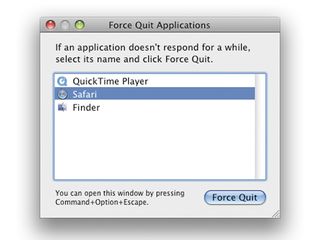

Select the app you want to quit from the dialogue box. Do the following: Press and hold the following keys: Command + Option + Esc. Alternatively, you can use a force quit Mac shortcut to close an unresponsive app.
#KEY SEQUENCE FOR HARD MAC FORCE QUIT HOW TO#
I hope you find this quick tutorial helpful. How to force quit using the keyboard shortcut. Ctrl+D is the shortcut to do the same and quit the terminal. When you exit from this shell, terminal ends as well. When you open a terminal in Ubuntu or any other Linux distribution, it runs the default shell. This actually exists you from the current shell. To exit the terminal itself, instead of closing the terminal, either use Ctrl+D keyboard shortcut or type the exit command: exit If you are inside the less command view, use the key q to exit less. The less is an excellent command that lets you view without cluttering your terminal screen like the cat command. It will ask if you want to save the changes made to the file or not. You may not understand it if you are new to it but at least you’ll be able to figure it out the next time. Why? Because Nano mentions the shortcut at the bottom. Quitting the Nano editor is a bit simpler than exiting Vim. Among several ways of quitting vim, the most common is to press the Esc key and then type a colon (:) and then type q! for force quit without save or wq for save and quit. It is difficult to figure out when you are new to this powerful command line based text editor. How to exit Vim editorĮxisting Vim editor has made so many jokes in the Linux world. Let me briefly mention some of them here. That’s more advanced stuff and used only when the process is running in the background or by another user or in another terminal window.Īpart from that, some other commands and command line tools have their own exit commands. You can find the process ID and kill a running process in a more complicated method. You feel like you have to cancel the command, use Ctrl+C. The Ctrl+C works very well for the commands designed to keep running until interrupted. So basically, the terminal shows the Ctrl+C keystrokes as ^C.

Stopping a program in the Linux terminalĭo you see the ^C? The caret (^) means Ctrl. It sends the SIGKILL signal to the running program to force quit the command. Hold the Ctrl button and press the C key at the same time. If you do not stop it, it will keep on displaying the result. This works for Ubuntu as well as any other Linux distribution. In Linux, you can use the Ctrl+C keys to stop a running program in the terminal. That’s not only unnecessary, but it is also a not good thing to do. Instead of stopping the command, he closed the entire terminal application. The other day, I found my friend could not figure out how to exit the top command. It’s amusing how the simplest of things could be complicated when you are new to something.


 0 kommentar(er)
0 kommentar(er)
